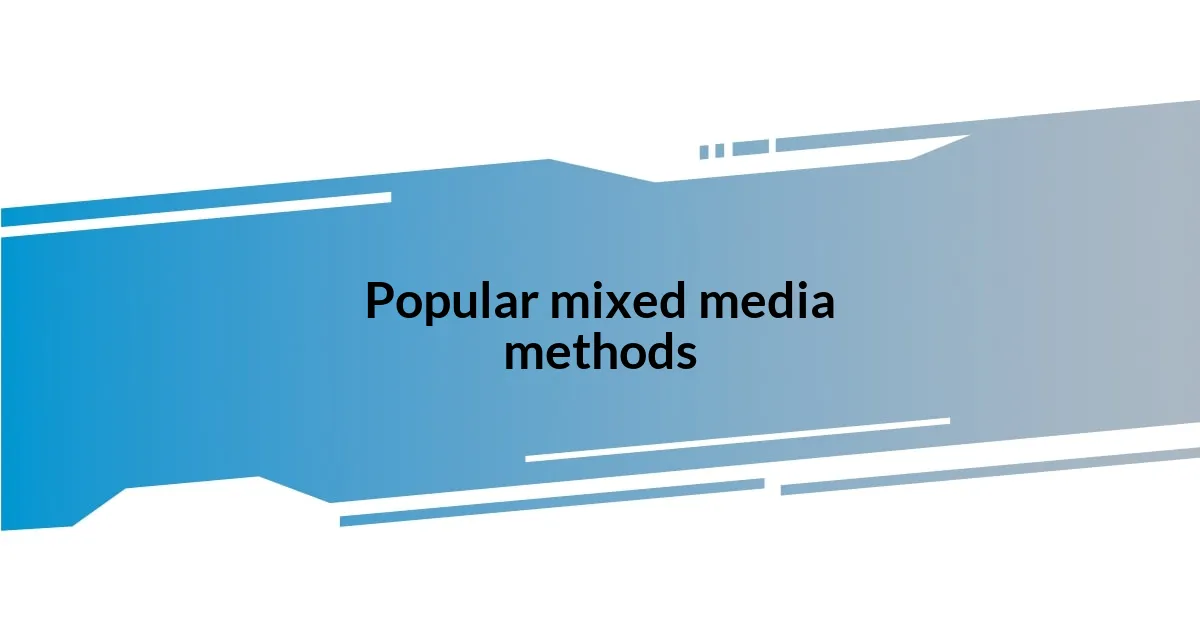Key takeaways:
- Mixed media techniques encourage creativity and experimentation, allowing artists to combine various materials for unique emotional expression and narratives in their artwork.
- Essential materials in mixed media, such as acrylic paints and found objects, enhance texture and personalization, contributing to the richness of the final piece.
- Popular methods like collage, encaustic painting, and printmaking introduce spontaneity and depth, providing fulfilling artistic experiences and unexpected outcomes.

Understanding mixed media techniques
Understanding mixed media techniques opens up a world of creativity and self-expression. Personally, I remember the first time I combined acrylic paints with collage elements. It felt exhilarating! The way the textures interacted sparked a new dimension in my artwork that I hadn’t experienced before. Have you ever felt that rush when making unexpected choices in your creative process?
What I truly love about mixed media is its flexibility; there are no hard and fast rules. Each layer can tell a different story, much like how my mood influences my choices of materials—sometimes I gravitate towards vibrant colors, while other days, I prefer subtle tones. Isn’t it fascinating how the combination of various mediums can evoke different emotions and reactions?
Diving deeper into mixed media techniques means embracing experimentation. The beauty lies in its unpredictability. I recall a piece where I incorporated old fabric scraps; the resulting texture added depth I hadn’t planned for. Have you ever stumbled upon surprising outcomes in your creative work? Those moments can lead to some of the most meaningful expression, making the entire process so worthwhile.

Benefits of using mixed media
Using mixed media opens up a treasure chest of benefits that can really enhance the creative process. One of the most rewarding aspects for me is how it encourages exploration and experimentation. I remember trying to incorporate natural elements, like leaves or twigs, into my piece. The organic textures combined with paint created a stunning visual contrast. It felt like a dialogue between nature and art, which enriched my emotional connection to the work.
Here are some key benefits of using mixed media:
- Enhanced Creativity: Mixing different materials stimulates innovative ideas and helps overcome creative blocks.
- Texture Variety: The ability to incorporate diverse textures adds depth and visual interest to artwork.
- Emotional Expression: Each medium can evoke distinct feelings, allowing for a richer narrative within the artwork.
- Personalization: Artists can infuse their unique style by combining personal materials, like found objects or photographs.
- Risk-taking: Experimentation with mixed media encourages outside-the-box thinking and can lead to unexpected, beautiful results.

Essential materials for mixed media
One of the most exciting aspects of mixed media is the wide array of materials you can use. From traditional paints to more unconventional items like fabric or even old newspapers, each component can bring something unique to your creation. I remember sourcing some old maps for a collage I was working on; their aged texture and intricate details added a historical narrative to my piece that I didn’t even realize it needed initially.
When it comes to essential materials, I find it helpful to think in layers. You’re not just choosing one kind of paint or one type of paper; instead, it’s like building a delicious sandwich where each layer enhances the flavor. For instance, combining watercolor with gel medium can yield a stunning opacity, turning a basic design into something rich and inviting. Have you tried mixing unexpected items in your projects? You might just find synergy where you least expect it!
Here’s a helpful comparison of some essential materials often used in mixed media:
| Material | Uses & Benefits |
|---|---|
| Acrylic Paints | Versatile, dries quickly, can be layered and mixed with other mediums. |
| Watercolor | Beautiful transparency, ideal for washes and delicate effects. |
| Collage Elements | Add texture and visual interest; can be anything from paper to fabric. |
| Pastels | Great for soft blending and creating a dreamlike quality. |
| Gel Medium | Enhances textures and helps layers adhere; can create a glossy finish. |
| Found Objects | Personalizes artwork; adds depth and story through unexpected materials. |

Popular mixed media methods
Exploring popular mixed media methods, I often find myself drawn to collage. There’s something inherently satisfying about layering different materials—the feel of magazine clippings and textured paper melding together beneath my fingers. Once, I created a piece that featured snippets from vintage postcards mixed with vibrant paints. It turned into a celebration of nostalgia, capturing not only visual beauty but also a sense of time and memory. Have you tried collage in your projects? It truly invites a conversation between the past and the present.
Another technique that fascinates me is encaustic painting, where you use heated beeswax to manipulate color and texture. The process requires patience, but the results are remarkably rewarding. I remember my first attempt; the way the wax glided over the surfaces and blended with pigments felt almost magical. It added an ethereal quality to my artwork, making it glow with a life of its own. Encaustic techniques can evoke a rich emotional response, as the wax seals the layers of history and narrative.
Finally, let’s not forget about ink and printmaking techniques, like monoprinting. This method allows for spontaneity—each print is unique. I once experimented with this technique, feeling the anticipation as I pressed paper against paint-covered surfaces. The unexpected details that emerged were a delightful surprise. I encourage you to delve into it; the excitement of unveiling each print can be electrifying and bring out a sense of playful exploration in your artistic journey. Have you explored the world of printmaking yet? There’s a certain thrill in that reveal.
